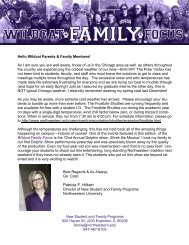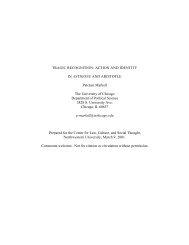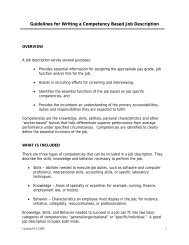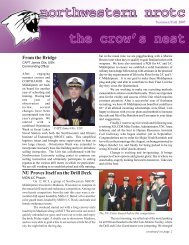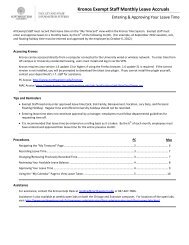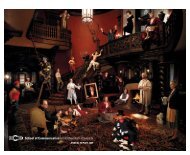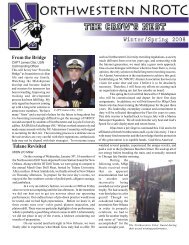Artistry Permits and Custom May Ordain - Northwestern University
Artistry Permits and Custom May Ordain - Northwestern University
Artistry Permits and Custom May Ordain - Northwestern University
Create successful ePaper yourself
Turn your PDF publications into a flip-book with our unique Google optimized e-Paper software.
16<br />
reference to mosques <strong>and</strong> large houses in Sofala, Ngoji (Angoche), 43 <strong>and</strong> Kilimani. 44<br />
Additionally, those structures that have been surveyed on the southern coast <strong>and</strong> in the<br />
Comoros display matching building materials <strong>and</strong> other resemblances to northern <strong>and</strong><br />
central coastal ornamental <strong>and</strong> structural design. 45<br />
43 I have elected to use the term Ngoji instead of the Portuguese word Angoche because Ngoji conforms to the<br />
original Swahili orthography. See A. de Mello Machado, Entre os Macuas de Angoche. Lisbon, 1970. 165-6; E.<br />
Rzewuski, “Origins of the Tungi Sultanate (Northern Mozambique) in the Light of Local Traditions,” in<br />
Unwritten Testimonies of the African Past. Ed. S. Pilaszewicz. 2 (1991): 207, 209 fn4. Rzewuski identifies Ngoji<br />
as the local (Swahili <strong>and</strong> Kóti) names for the isl<strong>and</strong>. Early Portuguese references to the town use the terms Angoji,<br />
Angoje, Angoja, Angosha, Angoxe, etc. The letter /A-/ is common before double consonants in Portuguese<br />
transcriptions of Swahili words <strong>and</strong> Bantu terms generally. There also seems to have been another Ngoji near<br />
modern Palma whose history records the first Shirazi Sultan of the isl<strong>and</strong> as Ahmadi Hassani—the nephew of<br />
female immigrants from Ngoji to the south. Rzewuski, “Mother Tongue/Father Tongue.” 277. Rzewuski records<br />
that another local name for Ngoji is Kilwa, or “the isl<strong>and</strong>.” Though the linguistic similarities between Swahili <strong>and</strong><br />
e-Kóti have not been thoroughly drawn out, Sacleux reported in the early twentieth century that the two languages<br />
were not mutually intelligible. Dictionaire Swahili-Français. Paris, 1939. 8.<br />
44<br />
From the written record it is clear that the material culture <strong>and</strong> linguistic<br />
coherency of towns <strong>and</strong> city-states in the Swahili world were ensured by close relationships<br />
between urban areas, the ease with which travel could be accomplished by sea, <strong>and</strong> an<br />
overarching agricultural base. One of the most distinguishing characteristics of Swahili<br />
society is that it was very much a maritime <strong>and</strong> mobile civilization. Cultural coherency was<br />
possible over extreme distances because transportation was relatively easy <strong>and</strong> inexpensive.<br />
Oceanic travel was highly integrative, connecting city-states on the coast to each other<br />
<strong>and</strong> to the wider Indian Ocean. Indeed, merchants from Kilwa, Malindi, <strong>and</strong> Mombasa<br />
“Carta de [João Velho, que foi feitor de Sofala,] para el-Rei, [Post 1547],” DPMAC. 7:172-4. The earliest<br />
remains identified south of Mozambique Isl<strong>and</strong> to date are those of Sancul. According to M. Guerreiro, an<br />
inscription dating 713 AH (1313-14 CE) appears on a tomb attributed to a descendant of ’Ali b. al-Hasan, the<br />
first Shirazi ruler at Kilwa. N. Chittick’s note in P. Vérin, “Observations Préliminaires sur les sites du<br />
Mozambique,” Azania. 5 (1970): 187. Vérin also notes that Islamic (Swahili style?) tombs have been found as<br />
far south as Chiloane (called Kilwani—an archaic Swahili form of “isl<strong>and</strong>”—by Ibn Majid). 188. Early Portuguese<br />
sources record Kilwani as a Swahili settlement ten leagues south of Sofala. “Regimento de Cide Barbudo, 1505<br />
Septembro,” DPMAC. 1:275.<br />
45 A. Rita-Ferreira, “Alguns Aspectos Materiais da Civilazação Suahili em Moçambique,” Leba. 7 (1992): 319-24;<br />
P. Sinclair, “Um Reconhecimento Arqueológico do Norte de Moçambique: Província de Cabo Delgado,” Trabalhos<br />
de Arqueologia e Anthropologia. 3 (1987): 23-82; A. Monteiro, “Vestiges Archéologiques du Cap Delgado et de<br />
Quisiva (Mozambique),” Taloha. 1970. 155-64; “Pesquisas Arqueológicas nos Establecimentos de Kiuya,<br />
M’buezi e Quisiva,” Monumenta. 2 (1966): 51-6. Plasterwork similar to northern examples can be seen in modern<br />
Mozambique. R. Teixeira Duarte, Northern Mozambique in the Swahili World. Uppsala, 1993. On Somana Isl<strong>and</strong>,<br />
which was settled no later than the thirteenth century, see idem, “Moçambique e o índico: Evidências<br />
arqueológicas,” Trabalhos de Arqueologia e Antropologia. 3 (1987): 5-20. On the Comoros, see H. Wright, “Early<br />
Islam, Oceanic Trade <strong>and</strong> Town Development of Nzwani: The Comorian Archipelago in the Xth-XVth Centuries<br />
AD,” Azania. 27 (1992): 81-128; P. Vialard, “Les Antiquités de la Gr<strong>and</strong> Comore,” Taloha. 4 (1971); <strong>and</strong> S.<br />
Blanchy, D. Ben Ali, <strong>and</strong> M. Saïd, Comores: Sur les Traces de l’Histoire. Moroni, 1989.



